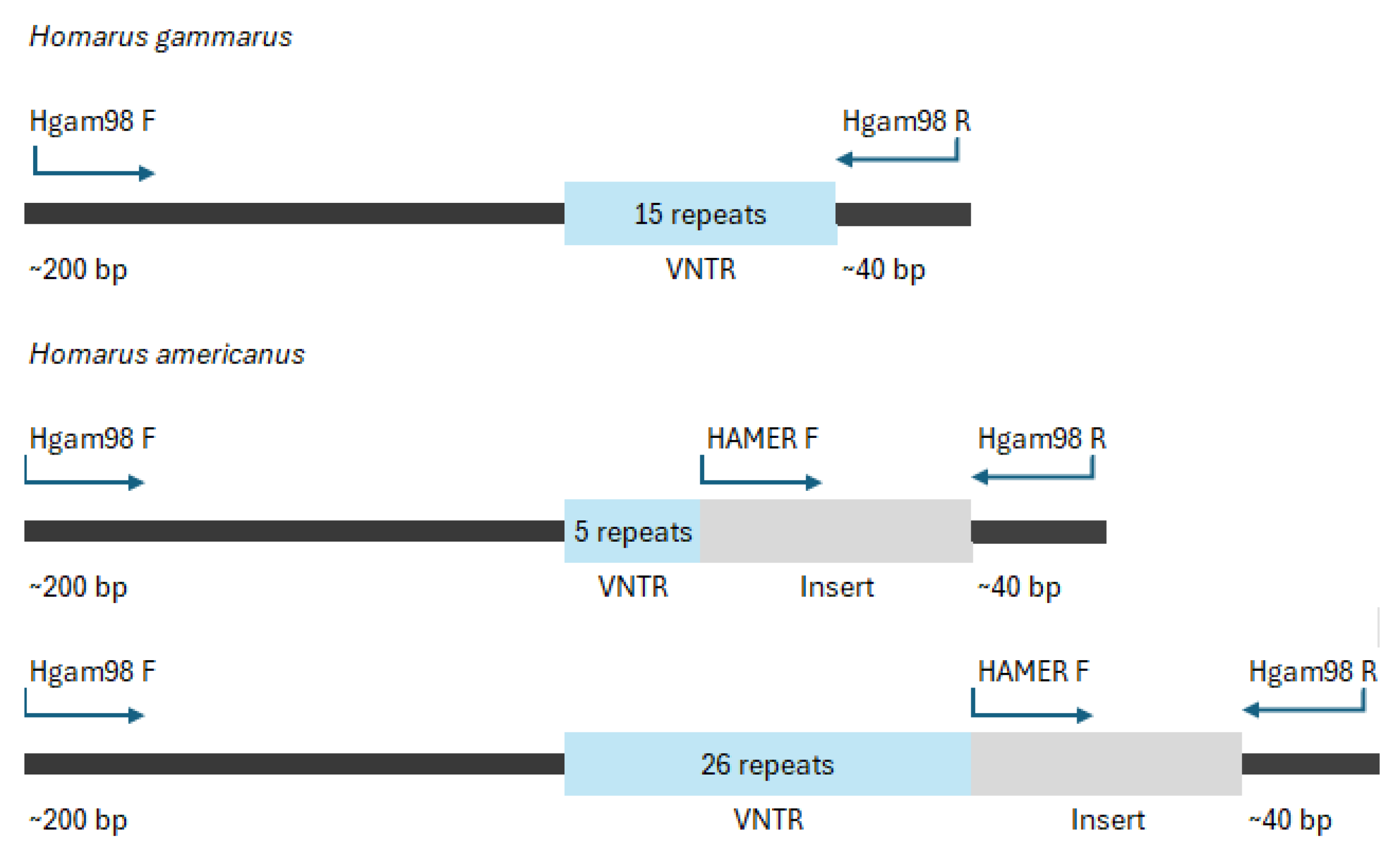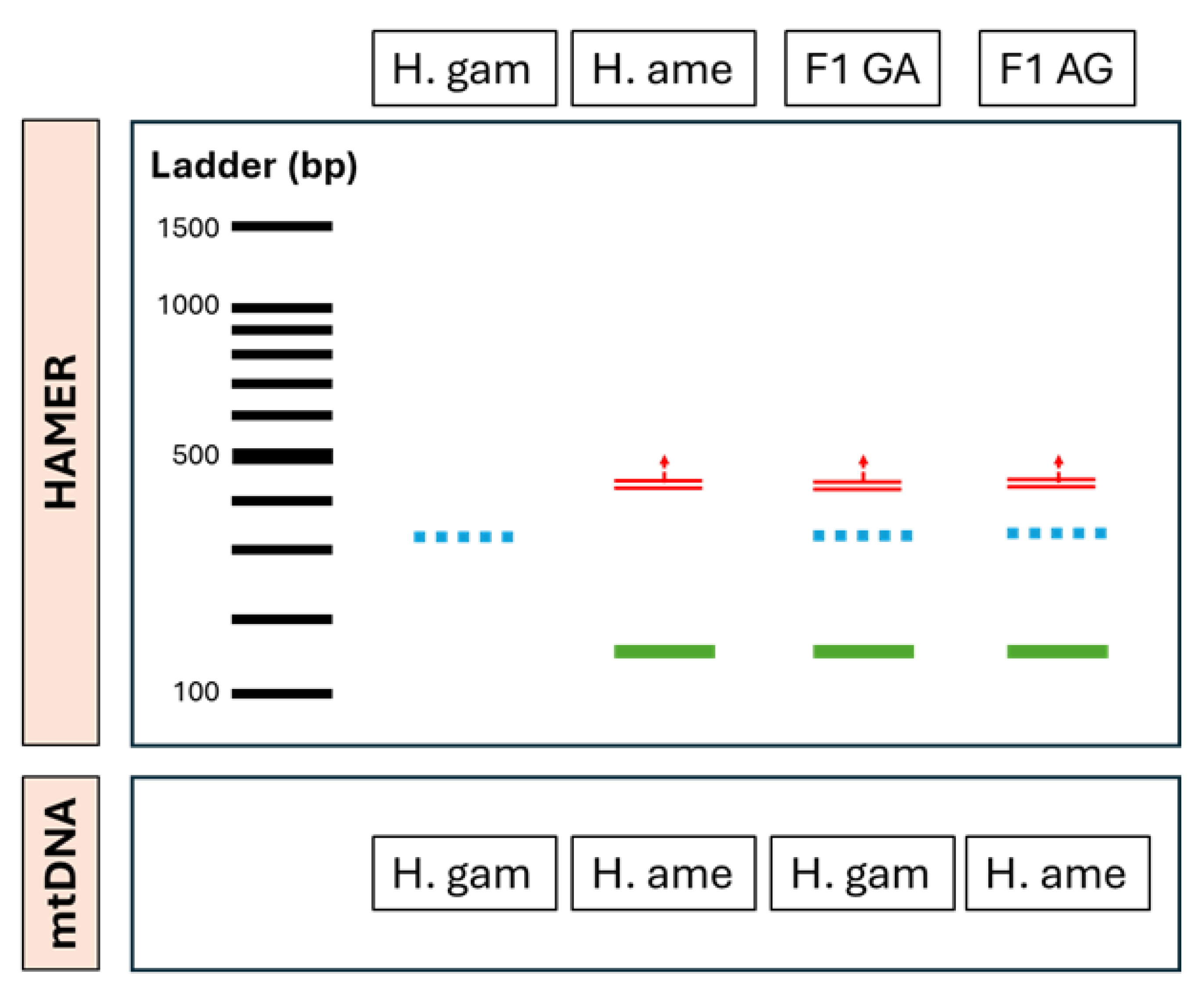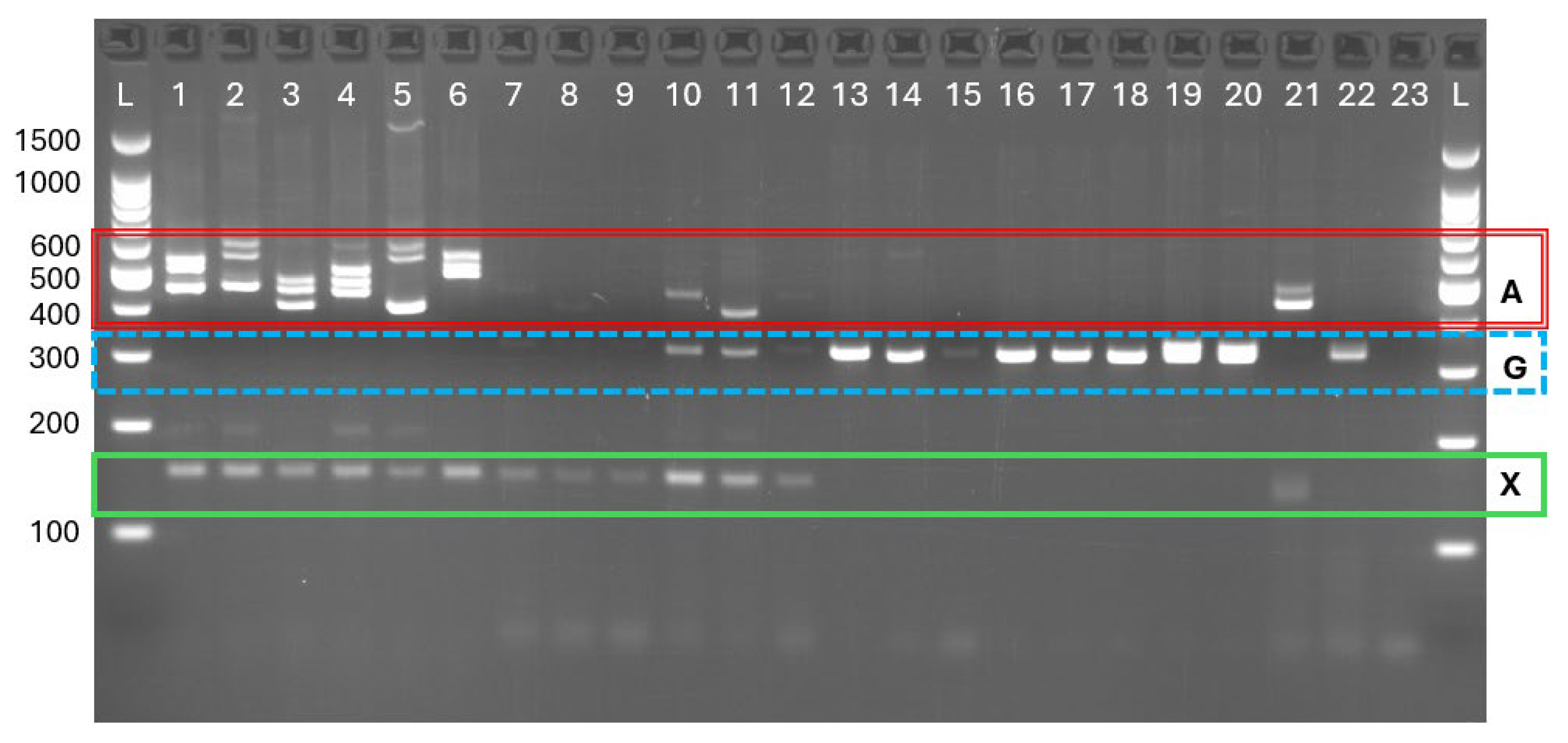Rapid and Cost-Effective Differentiation of the Lobsters Homarus americanus, H. gammarus and Their F1 Hybrids Using DNA-Based Methods
Abstract
1. Introduction
2. Materials and Methods
2.1. Biological Material and DNA Extraction
2.2. DNA Amplification and Sequencing
2.3. Duplex Conventional PCRs
2.4. Real-Time PCR Design and Application
3. Results
3.1. Duplex Conventional PCR
3.2. Sequencing the Hgam98 Locus
3.3. Real-Time PCR
4. Discussion
5. Conclusions
Supplementary Materials
Author Contributions
Funding
Institutional Review Board Statement
Data Availability Statement
Acknowledgments
Conflicts of Interest
Abbreviations
| Cox1 | Cytochrome c Oxidase gene 1 |
| NNS | Non-Native Species |
| PCR | Polymerase Chain Reaction |
| SNP | Single-Nucleotide Polymorphism |
| IFCA | Inshore Fisheries and Conservation Authorities |
| VNTR | Variable Nucleotide Tandem Repeat |
| eDNA | Environmental DNA |
References
- Manchester, S.J.; Bullock, J.M. The impacts of non-native species on UK biodiversity and the effectiveness of control. J. Appl. Ecol. 2000, 37, 845–864. [Google Scholar] [CrossRef]
- Eschen, R.; Kadzamira, M.; Stutz, S.; Ogunmodede, A.; Djeddour, D.; Shaw, R.; Pratt, C.; Varia, S.; Constantine, K.; Williams, F. An updated assessment of the direct costs of invasive non-native species to the United Kingdom. Biol. Invasions 2023, 25, 3265–3276. [Google Scholar] [CrossRef]
- Stewart, J.E. Gaffkemia, the Fatal Infection of Lobsters (Genus Homarus) Caused by Aerococcus viridans (var.) homari: A Review. Mar. Fish. Rev. 1975, 37, 20–24. [Google Scholar]
- Øresland, V.; Ulmestrand, M.; Agnalt, A.L.; Oxby, G. Recorded captures of American lobster (Homarus Americanus) in Swedish waters and an observation of predation on the European lobster (Homarus gammarus). Can. J. Fish. Aquat. Sci. 2017, 74, 1503–1506. [Google Scholar] [CrossRef]
- Stebbing, P.; Johnson, P.; Delahunty, A.; Clark, P.F.; McCollin, T.; Hale, C.; Clark, S. Reports of american lobsters, Homarus americanus (H. Milne Edwards, 1837), in British waters. BioInvasions Rec. 2012, 1, 17–23. [Google Scholar] [CrossRef]
- Mozer, A.; Prost, S. An introduction to illegal wildlife trade and its effects on biodiversity and society. Forensic Sci. Int. Anim. Environ. 2023, 3, 100064. [Google Scholar] [CrossRef]
- Ellis, C.D.; Jenkins, T.L.; Svanberg, L.; Eriksson, S.P.; Stevens, J.R. Crossing the pond: Genetic assignment detects lobster hybridisation. Sci. Rep. 2020, 10, 7781. [Google Scholar] [CrossRef]
- Jacquet, J.L.; Pauly, D. Trade secrets: Renaming and mislabeling of seafood. Mar. Policy 2008, 32, 309–318. [Google Scholar] [CrossRef]
- Jørstad, K.E.; Prodohl, P.A.; Agnalt, A.L.; Hughes, M.; Farestveit, E.; Ferguson, A.F. Comparison of genetic and morphological methods to detect the presence of American lobsters, Homarus americanus H. Milne Edwards, 1837 (Astacidea: Nephropidae) in Norwegian waters. Hydrobiologia 2007, 590, 103–114. [Google Scholar] [CrossRef]
- Mariani, S. Validating the Origin of Capture of Fish—Genetic Methodologies; MMO Project No: 1191; Marine Management Organisation: Newcastle upon Tyne, UK, 2019; p. 19. [Google Scholar]
- van der Meeren, G.I.; Chandrapavan, A.; Breithaupt, T. Sexual and aggressive interactions in a mixed species group of lobsters Homarus gammarus and H. americanus. Aquat. Biol. 2008, 2, 191–200. [Google Scholar] [CrossRef]
- Jenkins, T.L.; Ellis, C.D.; Stevens, J.R.; Jenkins, T.L. SNP discovery in European lobster (Homarus gammarus) using RAD sequencing. Conserv. Genet. Resour. 2019, 11, 253–257. [Google Scholar] [CrossRef]
- Kumar, S.; Stecher, G.; Tamura, K. MEGA7: Molecular Evolutionary Genetics Analysis Version 7.0 for Bigger Datasets. Mol. Biol. Evol. 2016, 33, 1870–1874. [Google Scholar] [CrossRef] [PubMed]
- Altschul, S.F.; Gish, W.; Miller, W.; Myers, E.W.; Lipman, D.J. Basic local alignment search tool. J. Mol. Biol. 1990, 215, 403–410. [Google Scholar] [CrossRef] [PubMed]
- Schrader, C.; Schielke, A.; Ellerbroek, L.; Johne, R. PCR inhibitors—Occurrence, properties and removal. J. Appl. Microbiol. 2012, 113, 1014–1026. [Google Scholar] [CrossRef] [PubMed]
- Kaltenboeck, B.; Wang, C. Advances in real-time PCR: Application to clinical laboratory diagnostics. Adv. Clin. Chem. 2005, 40, 219–259. [Google Scholar] [PubMed]



| Identification | Species | Location | Number of VNTRs (A[C/T]AG) | Accession Number |
|---|---|---|---|---|
| HAM1 | H. americanus | Browns Bank, Massachusetts, USA | 17 | PQ106807 |
| HAM2 | H. americanus | Caraquet, New Brunswick, Canada | 18 | PQ106808 |
| HAM3 | H. americanus | Coastal New Hampshire, USA | 5 | PQ106809 |
| HAM4 | H. americanus | Fortune Bay, Newfoundland and Labrador, Canada | 17 | PQ106810 |
| HAM5 | H. americanus | Malpeque Bay, Prince Edward Island, Canada | 26 | PQ106811 |
| HAM6 | H. americanus | Musquodoboit Harbour, Nova Scotia, Canada | 26 | PQ106812 |
| AxG1 | Hybrid animal | Lysekil, Sweden | 15 | PQ106813 |
| AxG2 | Hybrid animal | Lysekil, Sweden | 15 | |
| AxG3 | Hybrid animal | Lysekil, Sweden | 15 | |
| AxG4 | Hybrid animal | Lysekil, Sweden | 15 | |
| AxG5 | Hybrid animal | Lysekil, Sweden | 15 | |
| AxG6 | Hybrid animal | Lysekil, Sweden | 15 | |
| GAM1 | H. gammarus | Bergen, Norway | 15 | PQ106814 |
| GAM2 | H. gammarus | Flodevigen, Norway | 15 | |
| GAM3 | H. gammarus | Lysekil, Sweden | 15 | PQ106815 |
| GAM4 | H. gammarus | Tangiers, Morocco | 15 | PQ106816 |
| GAM5 | H. gammarus | Tangiers, Morocco | 15 | |
| GAM6 | H. gammarus | Tangiers, Morocco | 15 | |
| Corn1 | Unknown | Cornwall, UK | 15 | N/A |
| Corn2 | Unknown | Cornwall, UK | 15 | N/A |
| Primer/Probe Name | Primer Sequence | Target Species | Reference |
|---|---|---|---|
| Hgam98 F | 5′-GCCTCCGTCGGGTTTCCTG-3′ | H. gammarus/H. americanus | Jørstad et al. 2007 [9] (modified) |
| Hgam98 R | 5′-AATATGTCTTTCAATGGCTTCTCC-3′ | H. gammarus/H. americanus | Jørstad et al. 2007 [9] (modified) |
| Hamer F | 5′-ATAACGAGATAGTGTAGGG-3′ | H. americanus (Insert) | This study |
| COX1_H_SP_F | 5′-ACTGGRTGAACTGTCTACCC-3′ | H. gammarus/H. americanus | This study |
| COX1_H_SP_R | 5′-CCAGCYAGATGAAGCGAGAA-3′ | H. gammarus/H. americanus | This study |
| COX1_HA_Pr | 5′-[6FAM] CTCACGCAGGTGCTTCCGTTGA [TAM]-3′ | H. americanus | This study |
| COX1_HGam_Pr | 5′-[HEX] CGCTTCTGTTGATTTAGGAATTTTCTCGCT [TAM]-3′ | H. gammarus | This study |
Disclaimer/Publisher’s Note: The statements, opinions and data contained in all publications are solely those of the individual author(s) and contributor(s) and not of MDPI and/or the editor(s). MDPI and/or the editor(s) disclaim responsibility for any injury to people or property resulting from any ideas, methods, instructions or products referred to in the content. |
© 2025 by the authors. Licensee MDPI, Basel, Switzerland. This article is an open access article distributed under the terms and conditions of the Creative Commons Attribution (CC BY) license (https://creativecommons.org/licenses/by/4.0/).
Share and Cite
Edwards, M.; Ellis, C.; Batista, F. Rapid and Cost-Effective Differentiation of the Lobsters Homarus americanus, H. gammarus and Their F1 Hybrids Using DNA-Based Methods. Arthropoda 2025, 3, 15. https://doi.org/10.3390/arthropoda3040015
Edwards M, Ellis C, Batista F. Rapid and Cost-Effective Differentiation of the Lobsters Homarus americanus, H. gammarus and Their F1 Hybrids Using DNA-Based Methods. Arthropoda. 2025; 3(4):15. https://doi.org/10.3390/arthropoda3040015
Chicago/Turabian StyleEdwards, Matt, Charlie Ellis, and Frederico Batista. 2025. "Rapid and Cost-Effective Differentiation of the Lobsters Homarus americanus, H. gammarus and Their F1 Hybrids Using DNA-Based Methods" Arthropoda 3, no. 4: 15. https://doi.org/10.3390/arthropoda3040015
APA StyleEdwards, M., Ellis, C., & Batista, F. (2025). Rapid and Cost-Effective Differentiation of the Lobsters Homarus americanus, H. gammarus and Their F1 Hybrids Using DNA-Based Methods. Arthropoda, 3(4), 15. https://doi.org/10.3390/arthropoda3040015





